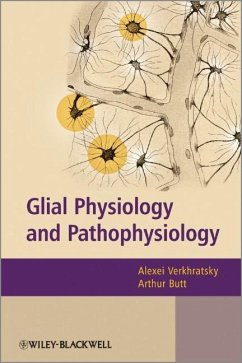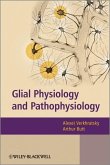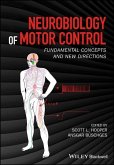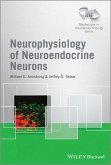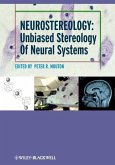Glial Physiology and Pathophysiology
Herausgegeben von Verkhratsky, Alexei; Butt, Arthur Morgan
Glial Physiology and Pathophysiology
Herausgegeben von Verkhratsky, Alexei; Butt, Arthur Morgan
- Gebundenes Buch
- Merkliste
- Auf die Merkliste
- Bewerten Bewerten
- Teilen
- Produkt teilen
- Produkterinnerung
- Produkterinnerung
This comprehensive advanced text on the biology and pathology of glial cells--the most numerous cells in the brain and an emerging field in neuroscience--offers detailed coverage of the morphology and interrelationships between glial cells and neurones in different parts of the nervous system. An accompanying website offers downloadable figures and slides.
Andere Kunden interessierten sich auch für
![Glial Physiology and Pathophysiology Glial Physiology and Pathophysiology]() Glial Physiology and Pathophysiology96,99 €
Glial Physiology and Pathophysiology96,99 €![Metabolic Syndrome and Neurological Disorders Metabolic Syndrome and Neurological Disorders]() Metabolic Syndrome and Neurological Disorders217,99 €
Metabolic Syndrome and Neurological Disorders217,99 €![Neurobiology of Motor Control Neurobiology of Motor Control]() Scott HooperNeurobiology of Motor Control205,99 €
Scott HooperNeurobiology of Motor Control205,99 €![Diet and Exercise in Cognitive Function and Neurological Diseases Diet and Exercise in Cognitive Function and Neurological Diseases]() Akhlaq A. FarooquiDiet and Exercise in Cognitive Function and Neurological Diseases211,99 €
Akhlaq A. FarooquiDiet and Exercise in Cognitive Function and Neurological Diseases211,99 €![Neurophysiology of Neuroendocrine Neurons Neurophysiology of Neuroendocrine Neurons]() William E. ArmstrongNeurophysiology of Neuroendocrine Neurons114,99 €
William E. ArmstrongNeurophysiology of Neuroendocrine Neurons114,99 €![Neuroinflammation Neuroinflammation]() Samuel DavidNeuroinflammation153,99 €
Samuel DavidNeuroinflammation153,99 €![Neurostereology Neurostereology]() P. R. MoutonNeurostereology141,99 €
P. R. MoutonNeurostereology141,99 €-
-
-
This comprehensive advanced text on the biology and pathology of glial cells--the most numerous cells in the brain and an emerging field in neuroscience--offers detailed coverage of the morphology and interrelationships between glial cells and neurones in different parts of the nervous system. An accompanying website offers downloadable figures and slides.
Produktdetails
- Produktdetails
- Verlag: Wiley & Sons
- 1. Auflage
- Seitenzahl: 560
- Erscheinungstermin: 15. April 2013
- Englisch
- Abmessung: 246mm x 173mm x 30mm
- Gewicht: 998g
- ISBN-13: 9780470978528
- ISBN-10: 047097852X
- Artikelnr.: 36693858
- Herstellerkennzeichnung
- Libri GmbH
- Europaallee 1
- 36244 Bad Hersfeld
- gpsr@libri.de
- Verlag: Wiley & Sons
- 1. Auflage
- Seitenzahl: 560
- Erscheinungstermin: 15. April 2013
- Englisch
- Abmessung: 246mm x 173mm x 30mm
- Gewicht: 998g
- ISBN-13: 9780470978528
- ISBN-10: 047097852X
- Artikelnr.: 36693858
- Herstellerkennzeichnung
- Libri GmbH
- Europaallee 1
- 36244 Bad Hersfeld
- gpsr@libri.de
Alexei Verkhratsky is Professor of Neurophysiology and Chairman of the Division of Neuroscience at the University of Manchester, UK. Arthur Butt is Professor of Cellular Neurophysiology, Department of Pharmacy and Biomedical Sciences, University of Portsmouth, UK.
Preface xvii
About the Authors xxi
Abbreviations xxv
About the Companion Website xxxii
1 History of Neuroscience and the Dawn of Research in Neuroglia 1
1.1 The miraculous human brain: localising the brain functions 1
1.2 Cellular organisation of the brain 10
1.3 Mechanisms of communications in neural networks 14
1.4 The concept of neuroglia 27
1.5 Beginning of the modern era 47
1.6 Concluding remarks 49
References 49
2 General Overview of Signalling in the Nervous System 59
2.1 Intercellular signalling: wiring and volume modes of transmission 59
2.2 Cellular signalling: receptors 62
2.3 Intracellular signalling: second messengers 67
2.4 Calcium signalling 67
2.5 Concluding remarks 72
3 Neuroglia: Definition, Classification, Evolution, Numbers, Development 73
3.1 Definition of neuroglia as homeostatic cells of the nervous system 74
3.2 Classification 75
3.3 Evolution of neuroglia 76
3.4 Numbers: how many glial cells are in the brain? 93
3.5 Embryogenesis and development of neuroglia in mammals 96
3.6 Concluding remarks 99
References 100
4 Astroglia 105
4.1 Definition and heterogeneity 107
4.2 Morphology of the main types of astroglia 113
4.3 How to identify astrocytes in the nervous tissue 119
4.4 Astroglial syncytial networks 120
4.5 Physiology of astroglia 125
4.6 Functions of astroglia 175
4.7 Concluding remarks 231
References 231
5 Oligodendrocytes 245
5.1 Oligodendrocyte anatomy 247
5.2 Myelin structure and function 252
5.3 Physiology of oligodendrocytes 266
5.4 Oligodendrocyte development 283
5.5 Concluding remarks 299
References 299
6 NG2-glial Cells 321
6.1 Definition of NG2-glia 321
6.2 Structure of NG2-glia 324
6.3 Physiology of NG2-glia 327
6.4 Proliferation of NG2-glia and generation of oligodendrocytes 332
6.5 Relationship between NG2-glia and CNS pericytes 333
6.6 Evolution of NG2-glia 336
6.7 Concluding remarks 337
References 337
7 Microglia 343
7.1 Definition of microglia 344
7.2 Microglial origin and development 345
7.3 Morphology of microglia 345
7.4 General physiology of microglia 351
7.5 Microglial migration and motility 372
7.6 Physiological functions of microglia: role in synaptic transmission and
plasticity 373
7.7 Microglia in ageing 375
7.8 Concluding remarks 375
References 376
8 Peripheral Glial Cells 381
8.1 Peripheral nervous system 382
8.2 Schwann cells 390
8.3 Satellite glial cells 407
8.4 Enteric glia 412
8.5 Olfactory ensheathing cells (OECs) 418
8.6 Concluding remarks 422
References 423
9 General Pathophysiology of Neuroglia 431
9.1 Neurological disorders as gliopathologies 431
9.2 Reactive astrogliosis 433
9.3 Wallerian degeneration 439
9.4 Excitotoxic vulnerability of oligodendrocytes: the death of white
matter 442
9.5 Activation of microglia 444
9.6 Concluding remarks 449
References 450
10 Neuroglia in Neurological Diseases 453
10.1 Introduction 454
10.2 Genetic astrogliopathology: Alexander disease 456
10.3 Stroke and ischaemia 458
10.4 Migraine and spreading depression 467
10.5 CNS oedema 469
10.6 Metabolic disorders 471
10.7 Toxic encephalopathies 473
10.8 Neurodegenerative diseases 474
10.9 Leukodystrophies 487
10.10 Epilepsy 488
10.11 Psychiatric diseases 490
10.12 Autistic disorders 491
10.13 Neuropathic pain 492
10.14 Demyelinating diseases 494
10.15 Infectious diseases 496
10.16 Peripheral neuropathies 499
10.17 Gliomas 501
10.18 Concluding remarks 504
References 504
Author Index 513
Subject Index 517
About the Authors xxi
Abbreviations xxv
About the Companion Website xxxii
1 History of Neuroscience and the Dawn of Research in Neuroglia 1
1.1 The miraculous human brain: localising the brain functions 1
1.2 Cellular organisation of the brain 10
1.3 Mechanisms of communications in neural networks 14
1.4 The concept of neuroglia 27
1.5 Beginning of the modern era 47
1.6 Concluding remarks 49
References 49
2 General Overview of Signalling in the Nervous System 59
2.1 Intercellular signalling: wiring and volume modes of transmission 59
2.2 Cellular signalling: receptors 62
2.3 Intracellular signalling: second messengers 67
2.4 Calcium signalling 67
2.5 Concluding remarks 72
3 Neuroglia: Definition, Classification, Evolution, Numbers, Development 73
3.1 Definition of neuroglia as homeostatic cells of the nervous system 74
3.2 Classification 75
3.3 Evolution of neuroglia 76
3.4 Numbers: how many glial cells are in the brain? 93
3.5 Embryogenesis and development of neuroglia in mammals 96
3.6 Concluding remarks 99
References 100
4 Astroglia 105
4.1 Definition and heterogeneity 107
4.2 Morphology of the main types of astroglia 113
4.3 How to identify astrocytes in the nervous tissue 119
4.4 Astroglial syncytial networks 120
4.5 Physiology of astroglia 125
4.6 Functions of astroglia 175
4.7 Concluding remarks 231
References 231
5 Oligodendrocytes 245
5.1 Oligodendrocyte anatomy 247
5.2 Myelin structure and function 252
5.3 Physiology of oligodendrocytes 266
5.4 Oligodendrocyte development 283
5.5 Concluding remarks 299
References 299
6 NG2-glial Cells 321
6.1 Definition of NG2-glia 321
6.2 Structure of NG2-glia 324
6.3 Physiology of NG2-glia 327
6.4 Proliferation of NG2-glia and generation of oligodendrocytes 332
6.5 Relationship between NG2-glia and CNS pericytes 333
6.6 Evolution of NG2-glia 336
6.7 Concluding remarks 337
References 337
7 Microglia 343
7.1 Definition of microglia 344
7.2 Microglial origin and development 345
7.3 Morphology of microglia 345
7.4 General physiology of microglia 351
7.5 Microglial migration and motility 372
7.6 Physiological functions of microglia: role in synaptic transmission and
plasticity 373
7.7 Microglia in ageing 375
7.8 Concluding remarks 375
References 376
8 Peripheral Glial Cells 381
8.1 Peripheral nervous system 382
8.2 Schwann cells 390
8.3 Satellite glial cells 407
8.4 Enteric glia 412
8.5 Olfactory ensheathing cells (OECs) 418
8.6 Concluding remarks 422
References 423
9 General Pathophysiology of Neuroglia 431
9.1 Neurological disorders as gliopathologies 431
9.2 Reactive astrogliosis 433
9.3 Wallerian degeneration 439
9.4 Excitotoxic vulnerability of oligodendrocytes: the death of white
matter 442
9.5 Activation of microglia 444
9.6 Concluding remarks 449
References 450
10 Neuroglia in Neurological Diseases 453
10.1 Introduction 454
10.2 Genetic astrogliopathology: Alexander disease 456
10.3 Stroke and ischaemia 458
10.4 Migraine and spreading depression 467
10.5 CNS oedema 469
10.6 Metabolic disorders 471
10.7 Toxic encephalopathies 473
10.8 Neurodegenerative diseases 474
10.9 Leukodystrophies 487
10.10 Epilepsy 488
10.11 Psychiatric diseases 490
10.12 Autistic disorders 491
10.13 Neuropathic pain 492
10.14 Demyelinating diseases 494
10.15 Infectious diseases 496
10.16 Peripheral neuropathies 499
10.17 Gliomas 501
10.18 Concluding remarks 504
References 504
Author Index 513
Subject Index 517
Preface xvii
About the Authors xxi
Abbreviations xxv
About the Companion Website xxxii
1 History of Neuroscience and the Dawn of Research in Neuroglia 1
1.1 The miraculous human brain: localising the brain functions 1
1.2 Cellular organisation of the brain 10
1.3 Mechanisms of communications in neural networks 14
1.4 The concept of neuroglia 27
1.5 Beginning of the modern era 47
1.6 Concluding remarks 49
References 49
2 General Overview of Signalling in the Nervous System 59
2.1 Intercellular signalling: wiring and volume modes of transmission 59
2.2 Cellular signalling: receptors 62
2.3 Intracellular signalling: second messengers 67
2.4 Calcium signalling 67
2.5 Concluding remarks 72
3 Neuroglia: Definition, Classification, Evolution, Numbers, Development 73
3.1 Definition of neuroglia as homeostatic cells of the nervous system 74
3.2 Classification 75
3.3 Evolution of neuroglia 76
3.4 Numbers: how many glial cells are in the brain? 93
3.5 Embryogenesis and development of neuroglia in mammals 96
3.6 Concluding remarks 99
References 100
4 Astroglia 105
4.1 Definition and heterogeneity 107
4.2 Morphology of the main types of astroglia 113
4.3 How to identify astrocytes in the nervous tissue 119
4.4 Astroglial syncytial networks 120
4.5 Physiology of astroglia 125
4.6 Functions of astroglia 175
4.7 Concluding remarks 231
References 231
5 Oligodendrocytes 245
5.1 Oligodendrocyte anatomy 247
5.2 Myelin structure and function 252
5.3 Physiology of oligodendrocytes 266
5.4 Oligodendrocyte development 283
5.5 Concluding remarks 299
References 299
6 NG2-glial Cells 321
6.1 Definition of NG2-glia 321
6.2 Structure of NG2-glia 324
6.3 Physiology of NG2-glia 327
6.4 Proliferation of NG2-glia and generation of oligodendrocytes 332
6.5 Relationship between NG2-glia and CNS pericytes 333
6.6 Evolution of NG2-glia 336
6.7 Concluding remarks 337
References 337
7 Microglia 343
7.1 Definition of microglia 344
7.2 Microglial origin and development 345
7.3 Morphology of microglia 345
7.4 General physiology of microglia 351
7.5 Microglial migration and motility 372
7.6 Physiological functions of microglia: role in synaptic transmission and
plasticity 373
7.7 Microglia in ageing 375
7.8 Concluding remarks 375
References 376
8 Peripheral Glial Cells 381
8.1 Peripheral nervous system 382
8.2 Schwann cells 390
8.3 Satellite glial cells 407
8.4 Enteric glia 412
8.5 Olfactory ensheathing cells (OECs) 418
8.6 Concluding remarks 422
References 423
9 General Pathophysiology of Neuroglia 431
9.1 Neurological disorders as gliopathologies 431
9.2 Reactive astrogliosis 433
9.3 Wallerian degeneration 439
9.4 Excitotoxic vulnerability of oligodendrocytes: the death of white
matter 442
9.5 Activation of microglia 444
9.6 Concluding remarks 449
References 450
10 Neuroglia in Neurological Diseases 453
10.1 Introduction 454
10.2 Genetic astrogliopathology: Alexander disease 456
10.3 Stroke and ischaemia 458
10.4 Migraine and spreading depression 467
10.5 CNS oedema 469
10.6 Metabolic disorders 471
10.7 Toxic encephalopathies 473
10.8 Neurodegenerative diseases 474
10.9 Leukodystrophies 487
10.10 Epilepsy 488
10.11 Psychiatric diseases 490
10.12 Autistic disorders 491
10.13 Neuropathic pain 492
10.14 Demyelinating diseases 494
10.15 Infectious diseases 496
10.16 Peripheral neuropathies 499
10.17 Gliomas 501
10.18 Concluding remarks 504
References 504
Author Index 513
Subject Index 517
About the Authors xxi
Abbreviations xxv
About the Companion Website xxxii
1 History of Neuroscience and the Dawn of Research in Neuroglia 1
1.1 The miraculous human brain: localising the brain functions 1
1.2 Cellular organisation of the brain 10
1.3 Mechanisms of communications in neural networks 14
1.4 The concept of neuroglia 27
1.5 Beginning of the modern era 47
1.6 Concluding remarks 49
References 49
2 General Overview of Signalling in the Nervous System 59
2.1 Intercellular signalling: wiring and volume modes of transmission 59
2.2 Cellular signalling: receptors 62
2.3 Intracellular signalling: second messengers 67
2.4 Calcium signalling 67
2.5 Concluding remarks 72
3 Neuroglia: Definition, Classification, Evolution, Numbers, Development 73
3.1 Definition of neuroglia as homeostatic cells of the nervous system 74
3.2 Classification 75
3.3 Evolution of neuroglia 76
3.4 Numbers: how many glial cells are in the brain? 93
3.5 Embryogenesis and development of neuroglia in mammals 96
3.6 Concluding remarks 99
References 100
4 Astroglia 105
4.1 Definition and heterogeneity 107
4.2 Morphology of the main types of astroglia 113
4.3 How to identify astrocytes in the nervous tissue 119
4.4 Astroglial syncytial networks 120
4.5 Physiology of astroglia 125
4.6 Functions of astroglia 175
4.7 Concluding remarks 231
References 231
5 Oligodendrocytes 245
5.1 Oligodendrocyte anatomy 247
5.2 Myelin structure and function 252
5.3 Physiology of oligodendrocytes 266
5.4 Oligodendrocyte development 283
5.5 Concluding remarks 299
References 299
6 NG2-glial Cells 321
6.1 Definition of NG2-glia 321
6.2 Structure of NG2-glia 324
6.3 Physiology of NG2-glia 327
6.4 Proliferation of NG2-glia and generation of oligodendrocytes 332
6.5 Relationship between NG2-glia and CNS pericytes 333
6.6 Evolution of NG2-glia 336
6.7 Concluding remarks 337
References 337
7 Microglia 343
7.1 Definition of microglia 344
7.2 Microglial origin and development 345
7.3 Morphology of microglia 345
7.4 General physiology of microglia 351
7.5 Microglial migration and motility 372
7.6 Physiological functions of microglia: role in synaptic transmission and
plasticity 373
7.7 Microglia in ageing 375
7.8 Concluding remarks 375
References 376
8 Peripheral Glial Cells 381
8.1 Peripheral nervous system 382
8.2 Schwann cells 390
8.3 Satellite glial cells 407
8.4 Enteric glia 412
8.5 Olfactory ensheathing cells (OECs) 418
8.6 Concluding remarks 422
References 423
9 General Pathophysiology of Neuroglia 431
9.1 Neurological disorders as gliopathologies 431
9.2 Reactive astrogliosis 433
9.3 Wallerian degeneration 439
9.4 Excitotoxic vulnerability of oligodendrocytes: the death of white
matter 442
9.5 Activation of microglia 444
9.6 Concluding remarks 449
References 450
10 Neuroglia in Neurological Diseases 453
10.1 Introduction 454
10.2 Genetic astrogliopathology: Alexander disease 456
10.3 Stroke and ischaemia 458
10.4 Migraine and spreading depression 467
10.5 CNS oedema 469
10.6 Metabolic disorders 471
10.7 Toxic encephalopathies 473
10.8 Neurodegenerative diseases 474
10.9 Leukodystrophies 487
10.10 Epilepsy 488
10.11 Psychiatric diseases 490
10.12 Autistic disorders 491
10.13 Neuropathic pain 492
10.14 Demyelinating diseases 494
10.15 Infectious diseases 496
10.16 Peripheral neuropathies 499
10.17 Gliomas 501
10.18 Concluding remarks 504
References 504
Author Index 513
Subject Index 517

